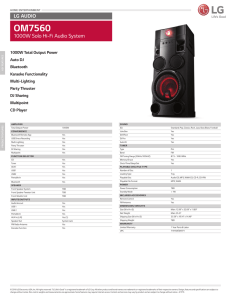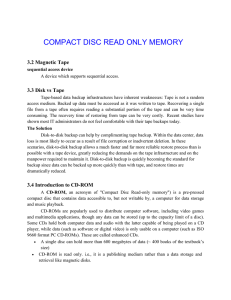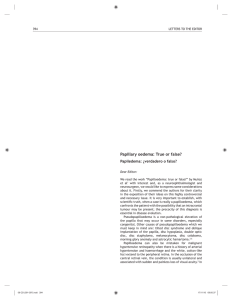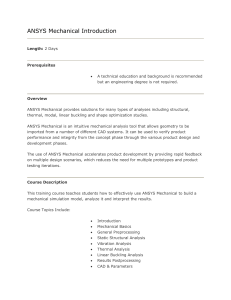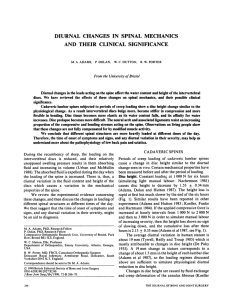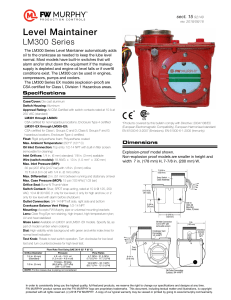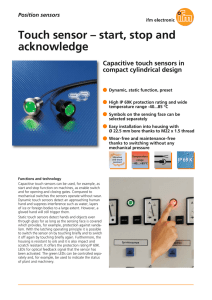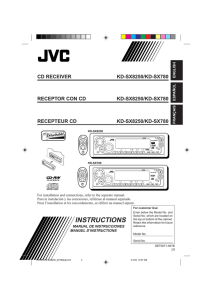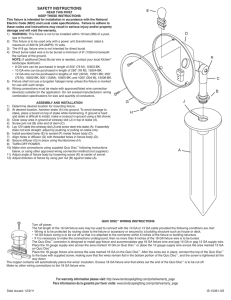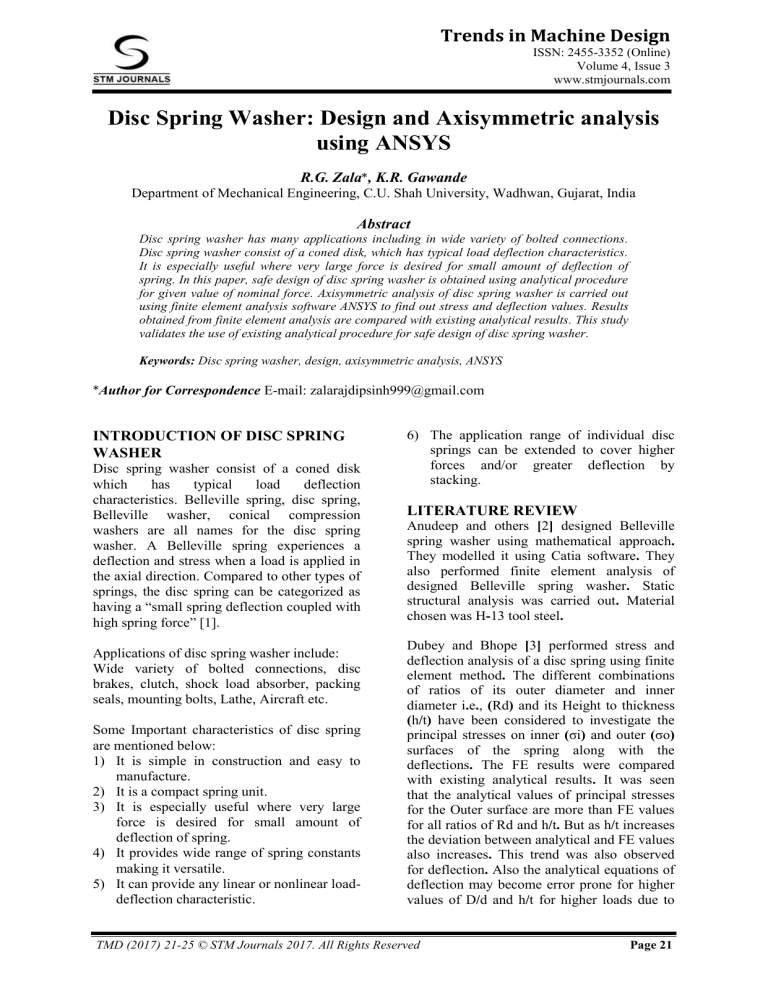
Trends in Machine Design ISSN: 2455-3352 (Online) Volume 4, Issue 3 www.stmjournals.com Disc Spring Washer: Design and Axisymmetric analysis using ANSYS R.G. Zala*, K.R. Gawande Department of Mechanical Engineering, C.U. Shah University, Wadhwan, Gujarat, India Abstract Disc spring washer has many applications including in wide variety of bolted connections. Disc spring washer consist of a coned disk, which has typical load deflection characteristics. It is especially useful where very large force is desired for small amount of deflection of spring. In this paper, safe design of disc spring washer is obtained using analytical procedure for given value of nominal force. Axisymmetric analysis of disc spring washer is carried out using finite element analysis software ANSYS to find out stress and deflection values. Results obtained from finite element analysis are compared with existing analytical results. This study validates the use of existing analytical procedure for safe design of disc spring washer. Keywords: Disc spring washer, design, axisymmetric analysis, ANSYS *Author for Correspondence E-mail: [email protected] INTRODUCTION OF DISC SPRING WASHER Disc spring washer consist of a coned disk which has typical load deflection characteristics. Belleville spring, disc spring, Belleville washer, conical compression washers are all names for the disc spring washer. A Belleville spring experiences a deflection and stress when a load is applied in the axial direction. Compared to other types of springs, the disc spring can be categorized as having a “small spring deflection coupled with high spring force” [1]. Applications of disc spring washer include: Wide variety of bolted connections, disc brakes, clutch, shock load absorber, packing seals, mounting bolts, Lathe, Aircraft etc. Some Important characteristics of disc spring are mentioned below: 1) It is simple in construction and easy to manufacture. 2) It is a compact spring unit. 3) It is especially useful where very large force is desired for small amount of deflection of spring. 4) It provides wide range of spring constants making it versatile. 5) It can provide any linear or nonlinear loaddeflection characteristic. 6) The application range of individual disc springs can be extended to cover higher forces and/or greater deflection by stacking. LITERATURE REVIEW Anudeep and others [2] designed Belleville spring washer using mathematical approach. They modelled it using Catia software. They also performed finite element analysis of designed Belleville spring washer. Static structural analysis was carried out. Material chosen was H-13 tool steel. Dubey and Bhope [3] performed stress and deflection analysis of a disc spring using finite element method. The different combinations of ratios of its outer diameter and inner diameter i.e., (Rd) and its Height to thickness (h/t) have been considered to investigate the principal stresses on inner (σi) and outer (σo) surfaces of the spring along with the deflections. The FE results were compared with existing analytical results. It was seen that the analytical values of principal stresses for the Outer surface are more than FE values for all ratios of Rd and h/t. But as h/t increases the deviation between analytical and FE values also increases. This trend was also observed for deflection. Also the analytical equations of deflection may become error prone for higher values of D/d and h/t for higher loads due to TMD (2017) 21-25 © STM Journals 2017. All Rights Reserved Page 21 Disc Spring Washer: Design and Axisymmetric analysis the non-linear behavior of the conical spring. They recommended finite element analysis for accurate estimation of stress and deflection in case of disc spring under given loading condition. Swieskowski [4] developed an analytical procedure for the design of Belleville washers for energy capacity. He determined the stress reduction that is obtained by replacing a single washer assembly by a nested arrangement. Also he determined the optimum stacking arrangement of Belleville spring. Dharan and Bavmen [5] performed feasibility study of replacing steel disc spring with composite materials. Design equations for steels were modified for composite materials. Several prototype disc springs were manufactured, tested. They were compared with equivalent steel springs. The results indicated that composite materials can replace steel for making disc spring. Moreover, there was considerable mass saving. Atxaga and others [6] performed failure analysis of various disc springs made of stainless steel. Patangtalo and others [7] performed analysis of isotropic and composite disc springs. An application of the Ritz method based on the energy approach was discussed to predict the deformation and load characteristics of such disc springs. Ozaki and others [8] analyzed effects of friction boundaries on static and dynamic behavior of coned disc spring. They used finite element method for this analysis. Karakaya [9] investigated the effectiveness of composite disc springs with different cross-section and Zala and Gawande hybrid type by taking into account some factors such as load capacities, costs etc. ABAQUS software was used for finite element analysis. DESIGN OF DISC SPRING WASHER It is required to design disc spring for bolted connection. Silicon steel is used as material for disc spring washer. Nominal force applied on spring is 29N. Outside diameter of spring required is 28 mm. Maximum deflection of spring is specified in range of 110% to 170% (Young’s modulus-E for silicon steel is 210 GPa. Poisson ratio-µ is 0.3. Yield strength value 𝝈y is 1375 MPa). Disc spring washer geometry is shown in Figure 1. Design of Disc spring washer needs iteration. Trail values of diameter radio Rd and h/t need to be chosen. Thickness can be obtained for given data using equation from [10], When disc spring washers with an h/t ratio greater than 1.4 are used in stack, the load deflection curve will be erratic as some washers will snap through the flat position. To avoid this problem, the h/t ratio for each washer in a stack should not exceed 1.4. So taking h/t=1.4, thickness value obtained is t= 0.40 mm. Thus, height of the disc h=0.56 mm. Fig. 1: Disc Spring Washer Geometry. TMD (2017) 21-25 © STM Journals 2017. All Rights Reserved Page 22 Trends in Machine Design Volume 4, Issue 3 ISSN: 2455-3352 (Online) For maximum energy storage taking value of diameter ration Rd=2 and using analytical design equations from [10], values of compressive stress, inner tensile stress and outer tensile stress can be obtained as 1063.17, 726.47 and 884.75 MPa, respectively. Here values of these stress is less than yield stress value so the design is considered to be safe. elements that can be used to model axisymmetric geometries with axisymmetric loads. These convert a 3D problem to a 2D problem. AXISYMMETRIC ANALYSIS USING ANSYS In order to do analysis using finite element analysis, finite element model of disc spring washer should be prepared first. Here disc spring washer, exhibits symmetry in geometry, material properties, loading and degree of freedom. So axisymmetric approach can be used to prepare finite element model of disc spring washer and to analyze it. A static analysis calculates the effects of steady loading conditions on a structure, while ignoring inertia and damping effects, such as those caused by time-varying loads. Linear static structural analysis of disc spring washer is carried out in this work. Thus, finite element model of disc washer is prepared considering axisymmetry. This model gives important data inputs for ANSYS analysis such as nodal coordinate, load data, degree of freedom data etc. Considering geometry of disc spring in bolted connection, it is clear that displacement in Y direction should be constrained at node 2 and displacement in X direction should be constrained at node 1. Axisymmetry is the symmetry about a central axis, as exhibited by structures such as light bulbs, straight pipes, cones, circular plates, domes etc. Axisymmetric elements are 2D Finite element model of disc spring washer is shown in Figure 2 which is important base for doing analysis using ANSYS. As Rd=2, inner diameter Di=14 mm. Also, free cone height of the disc lo= h+t =0.96 mm Thus, design specifications of disc spring washer are: Material=Silicon steel, Outer diameter Do=28 mm, Inner diameter Di=14 mm, Thickness of the disc spring washer t=0.40 mm, Free height of the disc spring washer lo=0.96 mm, Free cone height of the disc spring washer h=0.56 mm. Fig. 2: Finite Element Model of Disc Spring. TMD (2017) 21-25 © STM Journals 2017. All Rights Reserved Page 23 Disc Spring Washer: Design and Axisymmetric analysis Now, with the use of ANSYS software, finite element analysis of disc spring washer is carried out. Nodal displacement plot obtained in ANSYS is shown in Figure 3. It can be seen from Figure 3 that displacement value varies from 0.044 to 0.515 mm. Displacement is maximum at red colored area. Zala and Gawande Maximum Von mises stress obtained is shown in Figure 4. As shown, equivalent stress value varies from 1026 to 1197 MPa. Maximum stress occurs at area shown by red color. Minimum stress occurs at area shown by blue color. Note that these are Von mises stress equivalent values. Fig. 3: Nodal Displacement Plot. Fig. 4: Von Mises Stress Plot. TMD (2017) 21-25 © STM Journals 2017. All Rights Reserved Page 24 Trends in Machine Design Volume 4, Issue 3 ISSN: 2455-3352 (Online) Top most part of disc spring which is affected by nominal load is subjected to maximum stress. While bottom part of disc spring is subjected to minimum amount of stress which is shown by blue color. Figures also shows under formed model of disc spring which is shown by dark part having white colored borders. Also, Maximum Principal Stress value can be obtained using ANSYS which is 1230.59 MPa. CONCLUSIONS In this work, safe design of disc spring washer is evaluated using analytical procedure for given conditions. Using axisymmetric approach, finite element model of disc spring washer is prepared. With the help of ANSYS software finite element analysis of disc spring washer is carried out considering axisymmetric approach. Analytical procedure gives maximum value of stress as 1063.17 MPa. While finite element analysis gives maximum value of principal stress as 1230.59 MPa and maximum value of Von mises stress as 1197.15 MPa. These values obtained by analytical method and finite element analysis are less than yield stress value so the design is safe. Maximum deflection value by ANSYS is 0.52 mm, while our maximum deflection range is 0.6–0.9 mm. It can be said that analytical results do not deviate much from finite element analysis results for considered diameter ratio of 2. Moreover, axisymmetric analysis does not require developing 3D model of geometry yet gives satisfactory results. This study also validates use of existing analytical procedure for evaluating safe design of disc spring washer. REFERENCES 1. Christian Bauer. Disc Springs—Theory and Practice. Christian Bauer GMBH + CO. KG. 2. Anudeep B., Uppendra N., Suresh B., Design and Finite Element Analysis of H13 Tool Steel Belleville Spring Washer, Int J Mater Sci Eng, 2016; 4(4): 200– 207p. 3. Dubey HK, Bhope DV. Stress and Deflection Analysis of Belleville Spring, IOSR J Mech Civil Eng. 2012; 2(5): 1–6p. 4. Swieskowsi HP. Design Analysis of Belleville Washer Springs, Springfield Armory, Springfield, Mass. Research and Engineering, 1963. 5. Dharan CKH, Bavman JA. Composite disc springs, Composites Part A. 2007; (38): 2511–2516p. 6. Atxaga G, Pelayo A, Irisarri AM. Failure Analysis of a set of Stainless steel disc spring, Eng Fail Anal. 2005; 13: 226– 234p. 7. Patangtalo W, Aimmanee S, Chutima S. A unified analysis of isotropic and composite Belleville springs, Thin–Walled Struct. 2016; 109: 285–295p. 8. Ozaki S, Tsuda K, Tominaga J. Analysis of Static and Dynamic behavior of Coned disk springs: effects of friction boundaries, Thin–Walled Struct. 2012; 59: 132–143p. 9. Karakaya S. Investigation of hybrid and different cross-section composite disc springs using finite element method, T Can Soc Mech Eng. 2012; 36(4): 399– 412p. 10. Bhandari VB. Design of Machine Elements, 3rd edition. Noida: McGraw Hill Education; 2010. Cite this Article Zala RG, Gawande KR. Disc spring washer: design and axisymmetric analysis using ANSYS. Trends in Machine Design. 2017; 4(3): 21–25p. TMD (2017) 21-25 © STM Journals 2017. All Rights Reserved Page 25
